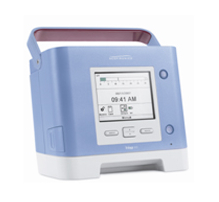More than 15 million adults are now estimated to be living with chronic obstructive pulmonary disease (COPD) in the U.S., with hospitals reportedly coming under increasing pressure to adhere to 30-day COPD readmissions standards.
A new study, results of which are published in the Journal of Clinical Sleep Medicine, investigates non-invasive ventilation as a key element of a multi-faceted intervention approach aimed at successfully reducing COPD patient readmission rates. The study, which was funded and co-authored by Royal Philips, evaluated COPD patients who had been hospitalized two or more times within a single year with an acute COPD exacerbation, and who had been transitioned to a COPD patient management program in which these same patients were treated using noninvasive positive pressure ventilation (NIPPV). Results of the study found a 97 percent reduction in the readmission rate in these patients during the subsequent 12 months.
The study, entitled “Retrospective Assessment of Home Ventilation to Reduce Rehospitalization in Chronic Obstructive Pulmonary Disease“ (J Clin Sleep Med 2015;11(6):663670 http://dx.doi.org/10.5664/jcsm.4780), is coauthored by Steven Coughlin, PhD, Director of Strategy, Health Economics and Reimbursement with Philips Respironics at Monroeville, PA; Wei E. Liang, PhD of Global Biostatistics, Clinical Affairs, Philips, Bothell, Washington; and Sairam Parthasarathy, MD of the Arizona Respiratory Center and Department of Medicine at the University of Arizona in Tucson.
The investigators note that healthcare systems are attempting to reduce hospital readmissions due to chronic obstructive pulmonary disease (COPD), and describe a retrospective study of a quality improvement (QI) program performed at a single center. This multifaceted intervention included nocturnal administration of advanced positive airway pressure (PAP) modality (or noninvasive positive pressure ventilation [NIPPV]) called averaged volume assured pressure support (AVAPS-AE) initiation by a respiratory therapist (RT), medication reconciliation by a pharmacist, adequate provision of oxygen, and ongoing RT-led care. Recruited for this QI program, were consecutive patients who had been as specified, hospitalized twice in a single year with an acute COPD exacerbation, and who underwent the above described interventions after they met specific selection criteria.
Among the 397 consecutive patients deemed eligible for the program because they had two or more hospitalizations in the previous year, the proportion of patients who were readmitted on two or more occasions decreased from 100% (397 of 397) in the year prior to initiation of intervention to 2.2% (9 of 397) in the following year (2 = 758, p < 0.0001). Seventy patients died over the one year following initiation of the multifaceted intervention.
A composite outcome of rehospitalization and death was associated with inhaled steroids (adjusted odds ratio [adjOR] of 2.13; 95% confidence interval [CI] 1.09, 4.17; p = 0.02), whereas inhaled antimuscarinics tended to be associated with less risk for rehospitalization or death.
 Each patient in the study was prescribed a Trilogy 100 ventilator manufactured by Philips Respironics for home use to deliver the NIPPV therapy. Continued in home care consisted of medication management, oxygen therapy, patient education and ongoing respiratory therapist care in the home.
Each patient in the study was prescribed a Trilogy 100 ventilator manufactured by Philips Respironics for home use to deliver the NIPPV therapy. Continued in home care consisted of medication management, oxygen therapy, patient education and ongoing respiratory therapist care in the home.
In the U.S., costs for hospital stays for patients with COPD as a principal diagnosis are estimated at approximately $29.5 billion (1), with the readmission rate within 30 days of discharge for patients with COPD has been reported to be as high as 22.6 percent (2). In this study, the proportion of COPD patients subsequently readmitted on two or more occasions decreased from 100% (397 of 397) in the year prior to initiation of intervention to 2.2% (9 of 397) in the following year.
“The results of this study indicate that Philips Trilogy with an advanced mode of ventilation AVAPs-AE therapy in combination with respiratory therapist-led care, medication reconciliation and adequate provision of oxygen therapy assisted in stabilizing the respiratory condition of patients with COPD,” comments Amy Day, RRT, Director of Ventilation Management of Barnes Healthcare Services, in a Philips release. “Such better management of the COPD condition allows health systems to not only significantly reduce readmissions and the associated high costs, but also improve the quality of life for some of its most complex patients.”
 “This study holds promise in how a multi-faceted intervention could assist health systems in significantly improving the care of the patients with advanced stage COPD in their home,” says Sairam Parthasarathy, MD Professor of Medicine and Director of the Center for Sleep Disorders at Banner University Medical Center Tucson. “The results indicate that patients placed on this advanced mode of non-invasive ventilation, combined with an in-home care program, can reduce hospitalizations and subsequently reduce healthcare utilization. This study is a good foundation to build from and to further validate.”
“This study holds promise in how a multi-faceted intervention could assist health systems in significantly improving the care of the patients with advanced stage COPD in their home,” says Sairam Parthasarathy, MD Professor of Medicine and Director of the Center for Sleep Disorders at Banner University Medical Center Tucson. “The results indicate that patients placed on this advanced mode of non-invasive ventilation, combined with an in-home care program, can reduce hospitalizations and subsequently reduce healthcare utilization. This study is a good foundation to build from and to further validate.”
Philips notes that with more treatments available to COPD patients today than ever before, they are living longer after diagnosis, and that home, portable non-invasive ventilators help homecare providers manage more patients with fewer resources, while allowing patients to live healthy lives at home.
 “The results of this are more critical now more than ever, given the industry’s increased focus on the high cost of chronic diseases and the need to reduce the re-hospitalization of COPD patients,” observes Eli Diacopoulos, Vice President and General Manager, Philips Respironics. “The use of Trilogy in this COPD management program is just one example of our ability to work with an innovative homecare provider partner to achieve a new kind of COPD care management model that connects and supports the clinician, caregiver, home care provider and the patient at every point along the patient care path.”
“The results of this are more critical now more than ever, given the industry’s increased focus on the high cost of chronic diseases and the need to reduce the re-hospitalization of COPD patients,” observes Eli Diacopoulos, Vice President and General Manager, Philips Respironics. “The use of Trilogy in this COPD management program is just one example of our ability to work with an innovative homecare provider partner to achieve a new kind of COPD care management model that connects and supports the clinician, caregiver, home care provider and the patient at every point along the patient care path.”
Philips Respironics affirms a commitment to innovating patient-centered COPD care management models, and the company is currently piloting a COPD care model that utilizes Bluetooth-enabled Trilogy devices and a tablet application tool to optimize clinician, caregiver and homecare provider coordination. This pilot project is its next step toward connected homecare solutions for respiratory patients.
Notes:
[1] Confronting COPD in America, 2000. Schulman, Ronca and Bucuvalas, Inc. (SRBI) Funded by Glaxo Smith Kline
[2] Jencks SF, Williams MV, Coleman EA. Rehospitalizations among patients in the Medicare fee-for-service program. N Engl J Med. April 2 2009;360(14):1478-1428.
For more information about Royal Philips, visit:
http://www.philips.com/
Sources:
Royal Philips
Journal of Clinical Sleep Medicine
Image Credits:
Royal Philips
University of Arizona

This is a miracle on a box that is helping me to breathe better feel better n most of all keep me out of the hosp n safe at home thank u isn’t enough for David g my life
That first deep breath was the most exciting thing that has ever happened to me. Thank you for this machine. I am considering registering it as my domestic partner.